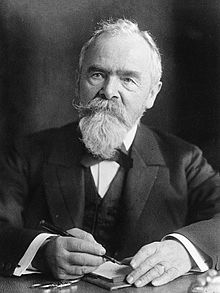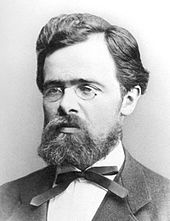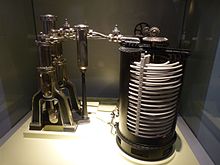Carl von Linde
Carl Paul Gottfried Linde , since 1897 Knight von Linde , (born June 11, 1842 in Berndorf near Thurnau , † November 16, 1934 in Munich ) was a German engineer, inventor and founder of what is now an international group, Linde plc . With the help of his Linde process, it was possible to develop the first refrigerators with today's cooling technology.
Life
Carl Linde was born as the third of nine children as the son of the Evangelical Lutheran pastor Friedrich Linde and his wife Franziska in Berndorf (Upper Franconia). For professional reasons - his father took over the parish of St. Mang - the family moved to the rectory in Kempten . Carl Linde was the only one of the four sons to attend the Humanistic Gymnasium in Kempten, which is now named after him ( Carl-von-Linde-Gymnasium Kempten ). With frequent visits to the stock cotton spinning mill in Kempten , he developed the desire to study engineering.
In 1861 Carl Linde began studying at the Zurich Polytechnic , where Rudolf Clausius , Gustav Zeuner and Franz Reuleaux were his teachers. In 1864 he finished his studies without a degree, as he was forced exmatriculated after participating in a student protest against the director Pompejus Bolley . Reuleaux found him an apprenticeship in the cotton factory of Kottern near Kempten (Allgäu) , which he started in the same year. However, he only stayed there for a short time and then worked - based on letters of recommendation from Zeuner and Reuleaux - as an engineer in the Borsig drawing office in Berlin from August 1865 . In February 1866 he moved to Munich to work as head of the design office at Georg Krauss's locomotive factory, which was being founded.
On February 26th, he got engaged and on September 17th, 1866, he married Helene Grimm, daughter of the attorney general in Berlin and a distant relative of his mother, in Kempten. The 53-year marriage had six children: Maria Linde (1867–1954), Franziska Linde (1868–1966), the physicist Friedrich Linde (1870–1965), Anna Linde (1873–1949), the mechanical engineer Richard Linde (1876 –1961) and Elisabeth Linde (1880–1959). Two of his daughters, Franziska and Anna, married Lutheran pastors. The eldest daughter Maria was married to the psychiatrist Karl Ranke, who was also a member of Linde AG's supervisory board from 1935 to 1948. His two sons Friedrich and Richard also joined the company and continued Carl von Linde's life's work, as did his son-in-law Rudolf Wucherer, the husband of their youngest daughter Elisabeth. In the next generation, the management of the company passed to Rudolf's son, Johannes Wucherer.
Carl von Linde had health problems such as frequent migraines and chronic stomach pains for most of his life, which he attributed to his grueling work. Since 1895 he spent more than three months in the Bavarian mountains every summer and during this time had business almost exclusively by letter. Only after he had reduced his physical overload did his health improve from the age of 60 to old age. Linde was not politically active. He died in 1934 at the age of 92 and was buried in the old part of the forest cemetery in Munich in grave no. 139-W-9b.
plant
University professor and inventor
In 1868 he followed a call from Karl Maximilian von Bauernfeind , the founding director of the Munich Polytechnic , the forerunner of today's Technical University of Munich. At the age of 26 he became an associate professor, and in 1872 he became a full professor of mechanical engineering . At the Polytechnic, Linde set up Germany's first machine laboratory for 70,000 guilders , in which Rudolf Diesel , among others , was trained.
Linde laid the foundations for modern refrigeration technology. A competition for a cooling system to crystallize paraffin was the incentive for the university professor to design a cooling machine. In 1871 Linde published an article on improved refrigeration technology in the Bayerischer Industrie- und Gewerbeblatt. In the summer of 1871 August Deiglmayr, director of the largest Austrian brewery Dreher , approached Linde with the question of whether it would be possible to build a cooling system for a fermentation cellar in their brewery in Trieste . With Deiglmayr's uncle, Gabriel Sedlmayr from the Munich Spaten Brewery , the two found another interested party who supported Linde both with premises in Munich and financially in its experiments. A Bavarian patent was applied for for the designed refrigeration machine on January 17, 1873, and the granting required that a functional copy existed within a year. Linde and Sedlmayr commissioned Maschinenfabrik Augsburg with the construction. The machine was ready on time and Sedlmayr submitted proof of commissioning on January 20, 1874, but there were massive difficulties because the mercury seal provided by Linde for the refrigerant dimethyl ether did not work properly. Therefore, at its own expense, Linde and his colleague Friedrich Schipper designed a new, simpler, lighter and more effective refrigeration machine with ammonia as the coolant. The principle of cooling gas , which had previously done mechanical work , was common to both. Linde registered the new compressor for a Bavarian patent on March 25, 1876 and in August 1877 for a Reich patent at the newly established Reich Patent Office: the patent was given the number 1250. The first new compressor was sold to the Dreher Brewery in Trieste in 1876 and ran there from 1877 to 1908. Further machines followed the Mainzer Actien-Bierbrauerei , Spaten in Munich, 1877 Heineken in the Netherlands and 1878 Carlsberg in Denmark.
Company formation
In 1879 the inventor gave up his teaching post and on June 21 of the same year founded the Gesellschaft für Linde's Eismaschinen Aktien-Gesellschaft in with Sedlmayr, Georg Krauss, Heinrich von Buz from Maschinenfabrik Augsburg, Carl Lang and Gustav Jung from Mainzer Aktien-Bierbrauerei Wiesbaden . Carl von Linde was the only board member, the other founders formed the supervisory board, with Carl Lang as chairman. After a relatively short time, the company was a leader in Europe in the field of refrigeration . Breweries all over Europe were promptly interested in this new refrigeration technology as a replacement for natural ice , as many had switched from top-fermented English beer to bottom-fermented lager from 1840 . The lager met the taste of many buyers and was more stable in storage, but required stable low temperatures during the brewing process. A mild winter of 1883/1884 had a positive effect: there was a shortage of natural ice, which was required for the temperature-regulated fermentation of bottom-fermented beer. The brewers' previous reservations about artificial ice melted away, cooling machines were suddenly in demand, and Linde delivered immediately. Linde even had cold stores for groceries and several ice works gradually built itself. His process was also in demand on ice rinks, in dairies and when liquefying chlorine and carbon dioxide , and the company flourished. By 1890, 625 refrigeration machines manufactured by Linde, most of them in breweries, were in operation.
Researcher and entrepreneur
In 1890, Linde was one of the founders of the Society for Market and Cooling Halls in Berlin. Its seat was Munich from 1895 and Hamburg from 1909. This company initially owned cold stores and ice cream factories in Hamburg and Berlin and later became the largest German cold store operator and market leader in the field of frozen food logistics. Linde was chairman of the supervisory board of this stock corporation for many years.
In 1890 Linde handed over the management board post of Linde Aktiengesellschaft to his employee Friedrich Schipper, withdrew from operational business and became chairman of the supervisory board - he held this position until 1931. In 1892 he moved back to Munich, where he accepted an honorary professorship at the Technical University. This was converted into a full professorship in 1900 and he again gave lectures on refrigeration machines. From 1893 to 1894 Linde worked on a carbon dioxide cooling machine, which he had the Augsburg machine factory built. Originally, he wanted to show the inferiority of the machines of the English competition and developed the process of air liquefaction from this in the following year. In 1895 Linde was one of the first to liquefy large quantities of air (at the same time, William Hampson , who submitted his patent before Linde , succeeded in doing this in England ). The Linde process uses the Joule-Thomson effect and is based on the countercurrent process . With this, Linde created the possibilities for physical low-temperature investigations and for the separation of the air components through fractional distillation .
In 1901 a plant for the production of oxygen and (from 1903) nitrogen was built . In 1903 Linde had a production facility built in Höllriegelskreuth in the south of Munich , which is still the largest location of the Linde Group today.
Memberships and honors
Linde was a member of numerous scientific and engineering associations. Among other things, he was a member of the Board of Trustees of the Physikalisch-Technische Reichsanstalt from 1895 and of the Bavarian Academy of Sciences from 1896 . In 1892 Linde became district chairman of the Association of German Engineers (VDI), in 1894 he became a member of the board, in 1895 a member of the scientific and technical commission of the VDI and in 1904/5 its chairman. In 1897 he was awarded the Grashof Memorial Medal (VDI). In 1903 he was involved in founding the Deutsches Museum as a board member and in 1909 was the founding chairman of the German refrigeration association (DKV).
He joined the Göttingen Association for Applied Physics and Mathematics - the intellectual forerunner of the Kaiser Wilhelm Society - in 1898. Linde was awarded the Knight's Cross of the Order of Merit of the Bavarian Crown by Prince Regent Luitpold in 1897 and raised to the personal nobility due to the statutes of the order . In 1907 he received the Maximilian Order . In 1916 he was the first winner of the Siemens Ring . In 1918 he became the holder of the Pour le Mérite order for sciences and arts .
He was awarded an honorary doctorate in 1897 by the University of Göttingen (Dr. phil. H. C.), In 1902 by the Dresden University of Technology (Dr.-Ing. E. h.) And in 1917 by the Vienna University of Technology (Dr. techn. H. C.). In 1922 he was awarded the Wilhelm Exner Medal . He is an honorary member of the experimental and educational institute for brewing .
The Carl-von-Linde-Gymnasium Kempten , the Carl-von-Linde-Realschule Munich and the Carl-von-Linde-Schule Kulmbach are named after Linde.
Linde process
The Linde process is a technical method developed by Carl von Linde to liquefy air . Sucked in air is compressed and the resulting heat dissipated by water cooling. The air is then relaxed again, where it cools down due to the Joule-Thomson effect . With a pressure gradient of 200 to 20 bar, the temperature is reduced by about 45 Kelvin . This cooled air pre-cools subsequent compressed air in a countercurrent heat exchanger, which pre-cools the next subsequent air. The continuous repetition leads to a progressive decrease in temperature, which ultimately leads to the liquefaction of air when the temperature falls below its boiling point. Hydrogen and helium are liquefied using the same process , whereby these gases must be pre-cooled with liquid air.
See also chiller and refrigerator .
Works
- Carl Linde: From my life and from my work . Updated reprint of the 1916 notes. Edited by Lisa Berger, Volker Gerndt and Werner Jakobsmeier. CreateSpace Independent Publishing Platform, 2014, ISBN 1-497-49791-4 (Paperback, 242 pages).
literature
- Kurt Mayer; Karl Michaelis: Linde, Carl Ritter von. In: New German Biography (NDB). Volume 14, Duncker & Humblot, Berlin 1985, ISBN 3-428-00195-8 , pp. 577-581 ( digitized version ).
- Florian Beierl: Carl von Linde. Inventor, entrepreneur and tourism pioneer on Obersalzberg. Klartext Verlag, Essen 2012. ISBN 978-3-8375-0784-3 .
Movie
- The Ice King Carl von Linde , documentary, 45 min., Broadcast on BR-alpha on July 14, 2011
Individual evidence
- ↑ a b c d e f g h Hans-Liudger Dienel : Die Linde AG. History of a technology company 1879–2004. CH Beck, Munich 2004, ISBN 3-406-51484-7 , p. 35–38 ( limited preview in Google Book search).
- ↑ a b c d e f Festschrift of Linde AG: 125 years of Linde. Eine Chronik , pp. 12–13, 2004 (PDF; 3 MB).
- ^ A b c Hans-Liudger Dienel: Die Linde AG. History of a technology company 1879–2004. CH Beck, Munich 2004, ISBN 3-406-51484-7 , p. 39–42 ( limited preview in Google Book search).
- ^ Hans-Liudger Dienel: Die Linde AG. History of a technology company 1879–2004. CH Beck, Munich 2004, ISBN 3-406-51484-7 , p. 144 ( limited preview in Google Book search).
- ^ A b c Hans-Liudger Dienel: Die Linde AG. History of a technology company 1879–2004. CH Beck, Munich 2004, ISBN 3-406-51484-7 , p. 49–53 ( limited preview in Google Book search).
- ↑ a b Rudolf Plank: The application of the cold in the food industry . Springer-Verlag, 2013, ISBN 978-3-642-86206-9 , pp. 551–552 ( limited preview in Google Book search).
- ↑ a b c d Festschrift of Linde AG: 125 years of Linde. Eine Chronik , pp. 7–10, 2004 (PDF; 3 MB).
- ^ German Refrigeration and Air Conditioning Association (DKV) eV: History. In: dkv.org. Retrieved November 25, 2018 .
- ↑ Rainer Scharf: Brief portraits of the ring bearers , Physikalisch-Technische Bundesanstalt , January 2018 ( online PDF 1.2 MB )
- ↑ Kurt Mayer; Karl Michaelis: Linde, Carl Ritter von. In: New German Biography (NDB). Volume 14, Duncker & Humblot, Berlin 1985, ISBN 3-428-00195-8 , pp. 577-581 ( digitized version ).
- ^ Carl Paul Gottfried von Linde, accessed on July 6, 2020 in Wilhelmexner.org
- ↑ website CvL Kempten
- ^ Website of the Carl-von-Linde-Realschule
- ^ Website of the Carl-von-Linde-Schule Kulmbach ( Memento of the original from March 25, 2016 in the Internet Archive ) Info: The archive link has been inserted automatically and has not yet been checked. Please check the original and archive link according to the instructions and then remove this notice.
Web links
- Literature by and about Carl von Linde in the catalog of the German National Library
- Newspaper article about Carl von Linde in the 20th century press kit of the ZBW - Leibniz Information Center for Economics .
- Wolfgang Gillmann: pioneer, scholar, entrepreneur. In: Handelsblatt online from January 20, 2010
- Entry about Carl Paul Gottfried von Linde in the database of the Wilhelm Exner Medal Foundation .
- Lecture by Carl Linde: Die Berliner Kühlhaus der Gesellschaft für Markt- und Kühlhallen Journal of the Association of German Engineers, November 1, 1902, p. 1643 ff. (PDF; 11.3 MB)
- Video at ARD-Alpha, 16 min (online until May 4, 2022) Stories of great minds: Fascination of technology Carl von Linde (1842–1934), engineer and entrepreneur, Oskar von Miller (1855–1934 / founder of the Deutsches Museum and electrical engineer ), Gabriel von Seidl (1848–1913 / architect) discuss on a stage in the old southern cemetery.
| personal data | |
|---|---|
| SURNAME | Linde, Carl von |
| ALTERNATIVE NAMES | Linde, Carl Paul Gottfried Ritter von (full name); Linde Carl; Linde, Carl Paul Gottfried |
| BRIEF DESCRIPTION | German engineer, inventor and founder of Linde AG |
| DATE OF BIRTH | June 11, 1842 |
| PLACE OF BIRTH | Berndorf , Upper Franconia |
| DATE OF DEATH | November 16, 1934 |
| Place of death | Munich |




